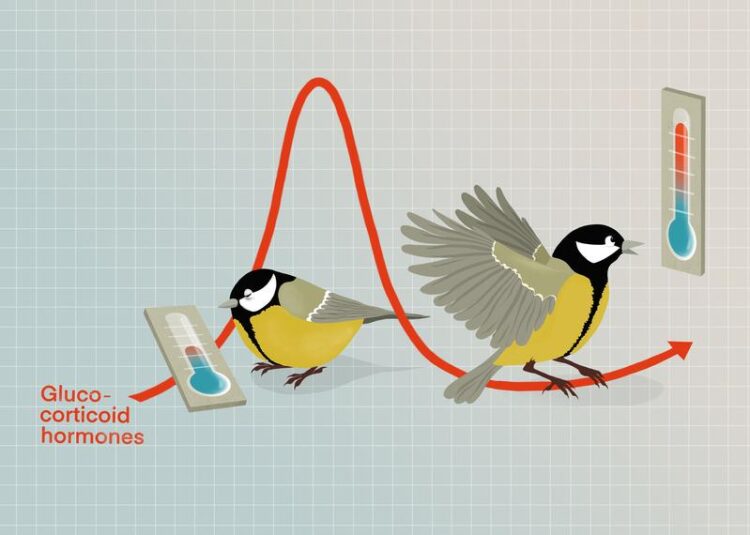Do hormone fluctuations increase survival probabilities?

Free-living great tits show large differences in how strongly their blood hormone levels vary with environmental temperatures. These differences could make it easier for bird populations to adjust to environmental conditions, such as temperature extremes.
© Max Planck Institute for Biological Intelligence (i.f.) / Julia Kuhl
Free-living great tits differ considerably in the level of stress hormones in their blood. A research project at the Max Planck Institute for Biological Intelligence (in foundation) studied the birds over several years.
The scientists observed large differences in how strongly glucocorticoid hormone levels fluctuated in individual great tits, as the birds experienced different environmental temperatures. Such differences among individuals can make it easier for bird populations to adapt to changing conditions – such as more frequent temperature extremes due to climate change.
Hormones control vital body functions in many animals, including birds. They help animals to regulate metabolism and food intake, thereby supporting them in maintaining their body temperature within a certain range. Glucocorticoids are stress hormones that coordinate many of the functions that help animals to cope with changes in their environment. On cold days, they are produced in larger amounts and help the body to use carbohydrate, fat, and protein reserves to generate heat. When temperatures are higher, glucocorticoid levels decrease and so does the conversion of energy into body heat.
In environments with widely fluctuating temperatures, stabilizing body temperature by hormones becomes increasingly important. Small warm-blooded animals such as birds must respond quickly to temperature fluctuations in order to maintain their body temperature. As a consequence of climate change, many habitats undergo major changes in environmental conditions, and extreme temperatures occur more frequently. Yet, how much does the climate affect the hormone balance of birds? Do individuals cope differently with climate change?
To answer these questions, data must be collected over several years. Research group leader Michaela Hau and two colleagues thus determined the glucocorticoid levels of a population of great tits in southern Bavaria over five years. They related their measurements to environmental temperatures and found, as expected, that hormone levels were higher at colder temperatures. However, there were also large differences in the responses of individual birds to temperature fluctuations.
“We observed for the first time in free-living vertebrates that some individuals show a more pronounced adjustment in glucocorticoid levels to environmental temperature than others,” says Michaela Hau. “This variation among individuals may allow populations to cope with a wide range of environmental conditions.” Further studies are needed to determine whether the observed hormonal differences among individuals lead to differences in heat production or resistance to heat loss. It is also unknown whether this individual variation is associated with increased reproductive success or survival.
“If the strength of glucocorticoid changes has a heritable component and individuals with certain hormonal responses produce more offspring or survive longer, natural selection may alter the composition of populations in subsequent generations,” Michaela Hau explains. “Our work therefore is an important basis for understanding whether and how animals can adapt to climate change.”
Wissenschaftliche Ansprechpartner:
Prof. Dr. Michaela Hau
Research Group Leader
Max Planck Institute for Biological Intelligence, in foundation
E-Mail: michaela.hau@bi.mpg.de
Originalpublikation:
Great tits differ in glucocorticoid plasticity in response to spring temperature
Michaela Hau, Caroline Deimel, Maria Moiron
Proceedings of the Royal Society B, online 9 November 2022
DOI: 10.1098/rspb.2022.1235
Weitere Informationen:
https://www.bi.mpg.de/hau – Research group website
Media Contact
All latest news from the category: Life Sciences and Chemistry
Articles and reports from the Life Sciences and chemistry area deal with applied and basic research into modern biology, chemistry and human medicine.
Valuable information can be found on a range of life sciences fields including bacteriology, biochemistry, bionics, bioinformatics, biophysics, biotechnology, genetics, geobotany, human biology, marine biology, microbiology, molecular biology, cellular biology, zoology, bioinorganic chemistry, microchemistry and environmental chemistry.
Newest articles

Innovative 3D printed scaffolds offer new hope for bone healing
Researchers at the Institute for Bioengineering of Catalonia have developed novel 3D printed PLA-CaP scaffolds that promote blood vessel formation, ensuring better healing and regeneration of bone tissue. Bone is…

The surprising role of gut infection in Alzheimer’s disease
ASU- and Banner Alzheimer’s Institute-led study implicates link between a common virus and the disease, which travels from the gut to the brain and may be a target for antiviral…

Molecular gardening: New enzymes discovered for protein modification pruning
How deubiquitinases USP53 and USP54 cleave long polyubiquitin chains and how the former is linked to liver disease in children. Deubiquitinases (DUBs) are enzymes used by cells to trim protein…



